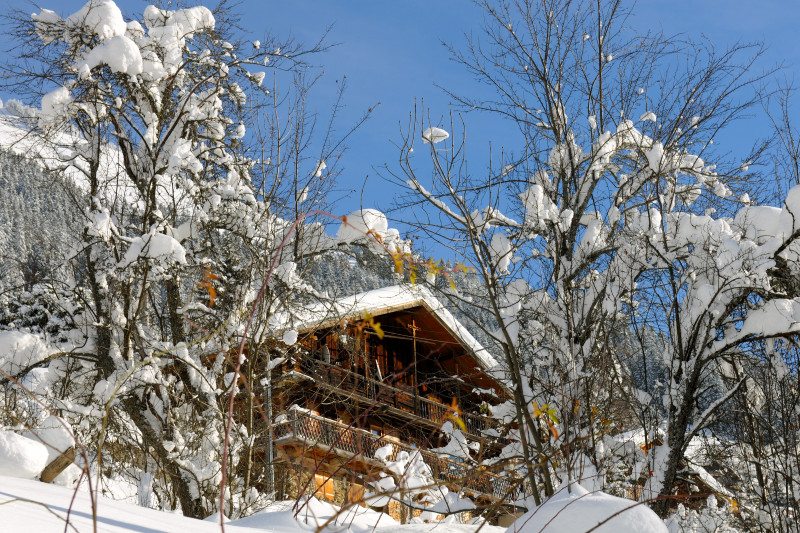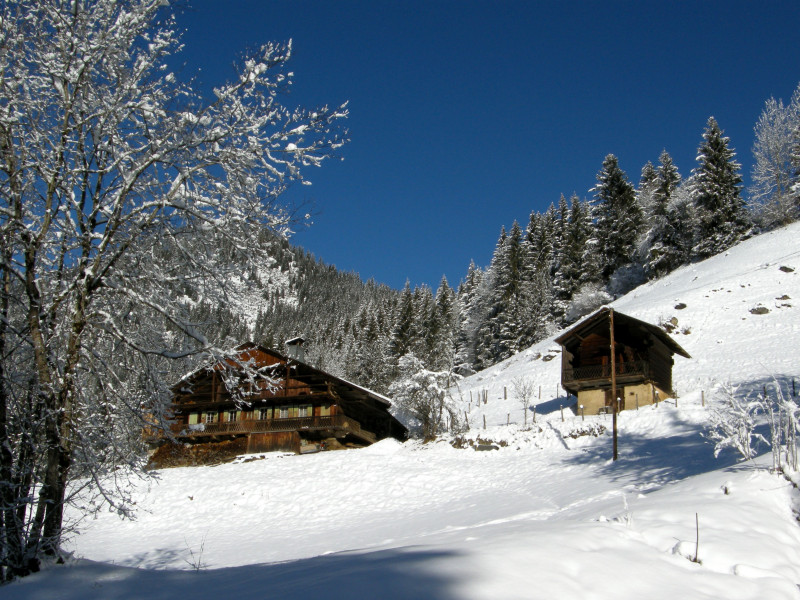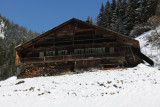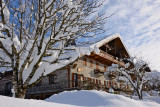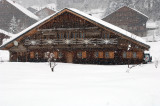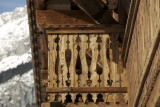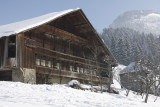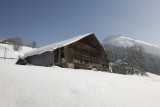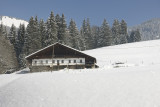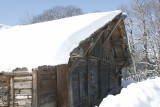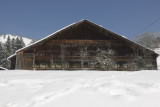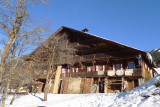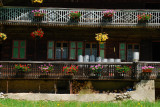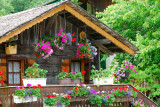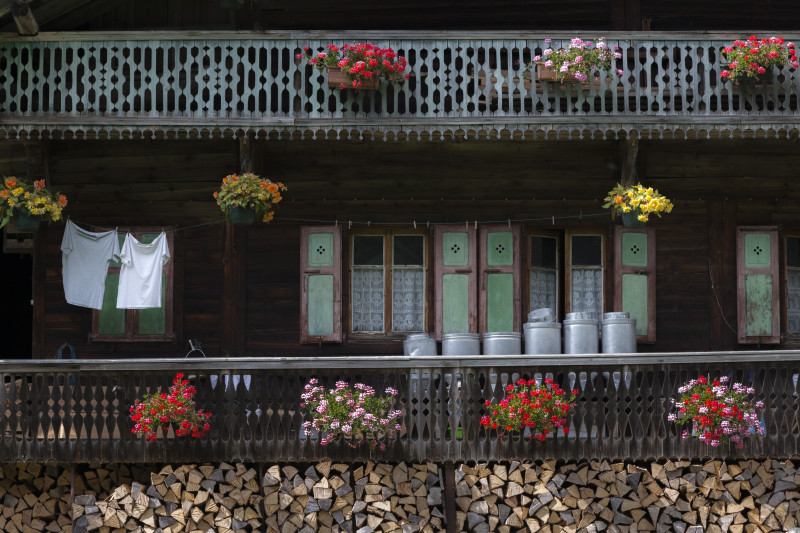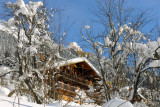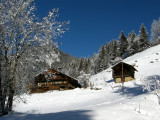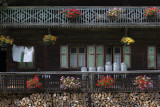The traditional chalets
Presentation
In matter of accommodation, each region has its specificity. In the Alps, from a valley to the other one, from a village to another one, buildings structures and materials are different: sometimes stone replaces the wood, the chimney is not the same everywhere.
The Abondance valley has the exceptional privilege to have its own type of chalet which amazes every visitor.
The roof always has two equal parts, gently sloping and overflowing on each side allowing the inhabitant to walk or work under cover in the winter.
The house is build against the mountainside and there is a big difference in level between the front side, the living area, and the back side, the barn.
The living area is facing south. At first, one is surprised by the massive facade made in spruce which has taken, year after year with sunny days as with time passing by, a nice reddish colour.
The entrance is, most of the time, on the side through the “cortna” (small yard), even if some front galleries have a door in their middle and stairs to go down to the garden and which can be used as the main access to the house.
From this little yard, a corridor takes one to the kitchen “l’outa”, then to a bigger room “le pêle” with an access to the living area gallery. From the “pêle” one can go from one room to another one.
Under the ridge piece, there is a devotion sign, a protection and maybe a humbleness sign in front of nature: a cross. On the beams you’ll often see a date as: 18 + 32.
Under the cover of the “cortna” there is a basin where water is pouring all day long. Two doors, separated by 2 m of wall, are giving access one to the lodging area and the other one to the stable. In between: the horse’s collar. This yard lets go from the stable to the kitchen without being bothered by the bad weather.
In the stable cows, heifers, and sometimes goats and a horse isolated by a wooden wall, facing their rack, are waiting for their food –hay- coming out from the top of the barn through little traps.
It’s very frequent to see double chalets build by two brothers or by a parent whishing to keep his children close to him, generally the oldest one. These chalets are strictly “divisible” from the “frête” of the roof, that is to say the ridge piece.
The roof slope is about 25% and the covering is made of slates coming from the place called “Essert” in Châtel. It can also be covered by “tavaillons”, those pieces of wood cut along the grain in coniferous trees with a chopping board knocked with a big mallet.
From centuries, the old chalets ornament the Abondance Valley scenery and some of them are 300 years old.
The balconies of the Abondance Valley are remarkable by their simplicity; the only thing which goes beyond this simplicity is the much elaborated balustrade of the large gallery that is the balcony. If the houses in Bonnevaux, Vacheresse and Chevenoz villages only have one balcony on the sun rising side, the one of Abondance, La Chapelle d’Abondance and Châtel can have until three superposed balconies, always protected from the wind by large eaves.
What are the balconies used for?
Below the balcony one piles up the wood which will slowly get dry there.
The gallery, also called “la louïe” is used to dry the hay or the aftermath. In older days it was the hemp and one can still see long horizontal batten fixed for that on the facade.
Sheltered from the rain and the wind, onion, garlic can slowly dry up before being removed inside. That’s also where the extra wood pieces for the roof covering where piled up. The top galleries all give access to the barn so the farmer can remove the dry hay easily using a door locked by a wooden plug.
The balcony decoration.
The vertical cut out boards, the baluster, that we call “palins” in our region, were generally the work of the chalet owner himself: a skilful inhabitant who always has a “workshop” where he patiently cuts out his wood during winter.
After the drawing and creation of a tinplate or wooden model, the farmer started the work... and he had to have his heart in his work to realise a beautiful balcony. Sometimes the “pretender” offered the “palins” of a balcony to his fiancée: a test which lasted a long time and which wasn’t useless, at least for the girl family.
The “palins” can be simple vertical wooden rails (old chalets) or uncut crossed ones. The juxtaposition of the cut boards is superb, geometric motifs, lozenges with flourishes, smart knot works...
With his saw, the “joiner-farmer” could almost write a message to his neighbours or to people passing by.
Glasses and bottles (les glaciers of Vacheresse), maple leaves, vine leaves, pine trees, tulips or daffodils (frequent in the Swiss region of Wallis).
To notice:
When the balconies are superposed in a chalet, the motifs are always different from one gallery to the other.
Some nice rounded balconies surrounding the chalet can be seen in La Chapelle d’Abondance (opposite Casino shop) and in Châtel the Vieux Four (opposite the post office): the Swiss touch is there.
The roof always has two equal parts, gently sloping and overflowing on each side allowing the inhabitant to walk or work under cover in the winter.
The house is build against the mountainside and there is a big difference in level between the front side, the living area, and the back side, the barn.
The living area is facing south. At first, one is surprised by the massive facade made in spruce which has taken, year after year with sunny days as with time passing by, a nice reddish colour.
The entrance is, most of the time, on the side through the “cortna” (small yard), even if some front galleries have a door in their middle and stairs to go down to the garden and which can be used as the main access to the house.
From this little yard, a corridor takes one to the kitchen “l’outa”, then to a bigger room “le pêle” with an access to the living area gallery. From the “pêle” one can go from one room to another one.
Under the ridge piece, there is a devotion sign, a protection and maybe a humbleness sign in front of nature: a cross. On the beams you’ll often see a date as: 18 + 32.
Under the cover of the “cortna” there is a basin where water is pouring all day long. Two doors, separated by 2 m of wall, are giving access one to the lodging area and the other one to the stable. In between: the horse’s collar. This yard lets go from the stable to the kitchen without being bothered by the bad weather.
In the stable cows, heifers, and sometimes goats and a horse isolated by a wooden wall, facing their rack, are waiting for their food –hay- coming out from the top of the barn through little traps.
It’s very frequent to see double chalets build by two brothers or by a parent whishing to keep his children close to him, generally the oldest one. These chalets are strictly “divisible” from the “frête” of the roof, that is to say the ridge piece.
The roof slope is about 25% and the covering is made of slates coming from the place called “Essert” in Châtel. It can also be covered by “tavaillons”, those pieces of wood cut along the grain in coniferous trees with a chopping board knocked with a big mallet.
From centuries, the old chalets ornament the Abondance Valley scenery and some of them are 300 years old.
The balconies of the Abondance Valley are remarkable by their simplicity; the only thing which goes beyond this simplicity is the much elaborated balustrade of the large gallery that is the balcony. If the houses in Bonnevaux, Vacheresse and Chevenoz villages only have one balcony on the sun rising side, the one of Abondance, La Chapelle d’Abondance and Châtel can have until three superposed balconies, always protected from the wind by large eaves.
What are the balconies used for?
Below the balcony one piles up the wood which will slowly get dry there.
The gallery, also called “la louïe” is used to dry the hay or the aftermath. In older days it was the hemp and one can still see long horizontal batten fixed for that on the facade.
Sheltered from the rain and the wind, onion, garlic can slowly dry up before being removed inside. That’s also where the extra wood pieces for the roof covering where piled up. The top galleries all give access to the barn so the farmer can remove the dry hay easily using a door locked by a wooden plug.
The balcony decoration.
The vertical cut out boards, the baluster, that we call “palins” in our region, were generally the work of the chalet owner himself: a skilful inhabitant who always has a “workshop” where he patiently cuts out his wood during winter.
After the drawing and creation of a tinplate or wooden model, the farmer started the work... and he had to have his heart in his work to realise a beautiful balcony. Sometimes the “pretender” offered the “palins” of a balcony to his fiancée: a test which lasted a long time and which wasn’t useless, at least for the girl family.
The “palins” can be simple vertical wooden rails (old chalets) or uncut crossed ones. The juxtaposition of the cut boards is superb, geometric motifs, lozenges with flourishes, smart knot works...
With his saw, the “joiner-farmer” could almost write a message to his neighbours or to people passing by.
Glasses and bottles (les glaciers of Vacheresse), maple leaves, vine leaves, pine trees, tulips or daffodils (frequent in the Swiss region of Wallis).
To notice:
When the balconies are superposed in a chalet, the motifs are always different from one gallery to the other.
Some nice rounded balconies surrounding the chalet can be seen in La Chapelle d’Abondance (opposite Casino shop) and in Châtel the Vieux Four (opposite the post office): the Swiss touch is there.
OpeningsAll year round, daily.
Features / Thematic
- Type of culturel patrimony :
- Historic site and monument
- Historical patrimony :
- Historic patrimony
- Farm
- categories :
- Town of Art & History
Contact us
The traditional chalets
74390
Châtel
Phone : +33 4 50 73 22 44
